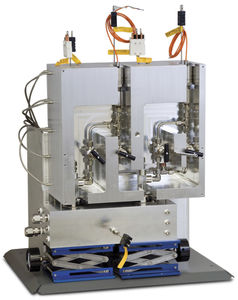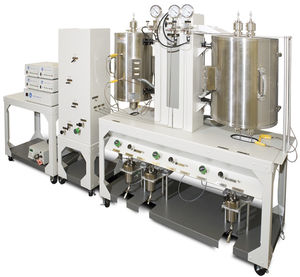
- Production Machines
- Other Manufacturing Equipment
- Fixed-bed reactor
- Parr Instrument Company
Fixed-bed reactor 5400 serieslaboratorytubularhigh-pressure
Add to favorites
Compare this product
Characteristics
- Type
- fixed-bed
- Applications
- laboratory
- Configuration
- tubular
- Treatment method
- high-pressure
Description
Tubular reactors are used in a continuous flow mode with reagents flowing in and products being removed. They can be the simplest of all reactor designs. Tubular reactors are often referred to by a variety of names:
• - Pipe reactors
• - Packed-bed reactors
• - Fixed-bed reactors
• - Trickle-bed reactors
• - Bubble-column reactors
• - Ebullating-bed reactors
Single-phase flow in a tubular reactor can be upward or downward. Two-phase flow can be co-current up-flow, counter-current (liquid down, gas up) or, most commonly, co-current down-flow.
Tubular reactors can have a single wall and be heated with an external electric furnace or they can be jacketed for heating or cooling with a circulating heat transfer fluid. External furnaces are typically rigid, split-tube heaters. Tubular reactors are used in a variety of industries:
• - Petroleum
• - Petrochemical
• - Polymer
• - Pharmaceutical
• - Waste Treatment
• - Specialty Chemical
• - Alternative Energy
Tubular reactors are used in a variety of applications:
• - Carbonylation
• - Dehydrogenation
• - Hydrogenation
• - Hydrocracking
• - Hydroformulation
• - Oxidative decomposition
• - Partial oxidation
• - Polymerization
• - Reforming
Tubular reactors may be empty for homogenous reactions or packed with catalyst or other solid particles for heterogeneous reactions. Packed reactors require upper and lower supports to hold particles in place. Upper packing often includes inert material to serve as a pre-heat section. Pre-heating can also be done with an internal spiral channel to keep incoming reagents close to the heated wall during entry, as shown to the right.
Catalogs
Tubular Reactor Systems
12 Pages
4500MB Stirred Reactors
176 Pages
Other Parr Instrument Company products
Specialty & Custom Systems
Related Searches
- Laboratory-scale reactor
- Process reactor
- Pressure reactor
- Steel reactor
- Chemical reactor
- Stainless steel reactor
- Stirred-tank reactor
- Multiple reactor
- Benchtop reactor
- High-pressure reactor
- Multipurpose reactor
- Reactor with mixer
- Low-temperature reactor
- Custom reactor
- Batch reactor
- Catalytic reactor
- Parallel synthesis reactor
- Reactor with thermostat
- Tubular reactor
- Micro reactor
*Prices are pre-tax. They exclude delivery charges and customs duties and do not include additional charges for installation or activation options. Prices are indicative only and may vary by country, with changes to the cost of raw materials and exchange rates.









